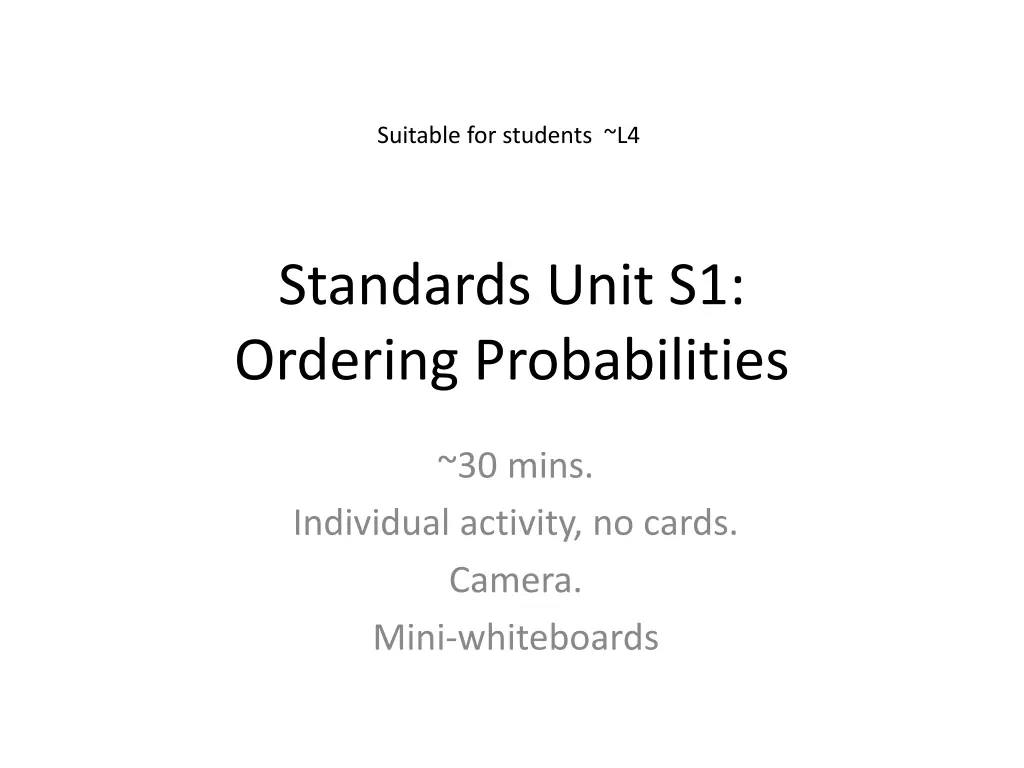
Ordering Probabilities for Students: Interactive Math Activity
Engage students in a 30-minute probability lesson focused on ordering likelihoods. Utilize mini-whiteboards and visual aids to explore different probabilities from impossible to certain. Encourage students to assess the likelihood of events and practice decimal place value skills.
Download Presentation

Please find below an Image/Link to download the presentation.
The content on the website is provided AS IS for your information and personal use only. It may not be sold, licensed, or shared on other websites without obtaining consent from the author. If you encounter any issues during the download, it is possible that the publisher has removed the file from their server.
You are allowed to download the files provided on this website for personal or commercial use, subject to the condition that they are used lawfully. All files are the property of their respective owners.
The content on the website is provided AS IS for your information and personal use only. It may not be sold, licensed, or shared on other websites without obtaining consent from the author.
E N D
Presentation Transcript
Suitable for students ~L4 Standards Unit S1: Ordering Probabilities ~30 mins. Individual activity, no cards. Camera. Mini-whiteboards
Extremely Unlikely
Equally Likely
Fairly Likely
Most Likely
Highly Likely
Consumable Resources Needed: Re-usable Resources Needed: Certain , Unlikely , Never etc. cards. These are laminated so that decimal numbers can be written on them, and erased, too. Mini-whiteboards for each student.
Notes to start. Mini-whiteboards for each student. Partners needed for last assessment activity, and possibly at start too. Ensure laminated cards are clean from pervious use. Give some of the students (some of) the Likely , Certain cards [Give them all at once for competent groups, or just a selection of the easiest for less-able groups]. Start lesson by asking class to assist them in self-ordering. Add in some other cards if desired. Then fix them in order, with blu-tac around room. When students estimate a numerical value of their own even, ensure they do it in DECIMALS and allow them to quote it to differing numbrs of decimal places. Wehen they line up in order, it will then also assess their ability to read place value / decimals correctly.
Events An event is something that could happen in the future. e.g. It will rain tomorrow. I will be asleep at 7am next Saturday. I will cycle home from school tonight. I will cycle home from school tonight. I will cycle home from school tonight. Some more? Write your own event on your mini-whiteboard.
How likely is your Event? Think how likely your event is to really happen. Is it absolutely certain to happen? Or do you just hope it will? Stand beside the correct description of your event.
Write 0 on Impossible card, and 1 on Certain card Probabilities What numbers should I write on the other cards? Write a more exact number on your card (Estimate) I will expect it to be close to its description. Sometimes we can accurately predict the probability of something happening. e.g. rolling a dice and getting a 4 . Sometimes it is very difficult / impossible to predict the probability. e.g. it will be sunny next Monday at 10.00am. Are you sure that probability is accurate? Even a weather forecaster would have to guess a bit! Now order yourself even more accurately.
The following notes and task should either be completed individually in books, or as a paired activity in creating a poster.
Probability An EVENT is something that could happen in the future. e.g. throwing a 5 on a die e.g. it raining all next Wednesday afternoon Accurately draw your own probability line, with at least 6 written descriptions (including these two) B D C A Certain Impossible 1. Make up 4 different events of your own. Label them A, B, C and D. 2. Estimate the probability of each of these actually happening. Write: p(A) = p(B) = p(C) = p(D) = 3. Place and label them accurately on your diagram
Assessment Questions 1 Each have a mini-whiteboard. Work with your partner to answer questions. You have a 6-sided die. Show me: an event that has a probability of 1/6. an event that has a probability of 2/6 (or 1/3). an event that has a probability of 3/6 (or 1/2). another event that has a probability of 3/6 (or 1/2).
Assessment Questions 2 Now think about sporting events in the future. Show me: an event that is Impossible. an event you think has a probability of about 0.75 an event that has a probability of about 0.05 an event that has a probability of about 1.5 an event you think has an even chance of occurring
